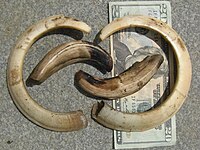Tusk

Tusks are elongated, continuously growing front teeth that protrude well beyond the mouth of certain mammal species. They are most commonly canine teeth, as with narwhals, chevrotains, musk deer, water deer, muntjac, pigs, peccaries, hippopotamuses and walruses, or, in the case of elephants, elongated incisors. Tusks share common features such as extra-oral position, growth pattern, composition and structure, and lack of contribution to ingestion. Tusks are thought to have adapted to the extra-oral environments, like dry or aquatic or arctic.[1] In most tusked species both the males and the females have tusks although the males' are larger. Most mammals with tusks have a pair of them growing out from either side of the mouth. Tusks are generally curved and have a smooth, continuous surface. The male narwhal's straight single helical tusk, which usually grows out from the left of the mouth, is an exception to the typical features of tusks described above. Continuous growth of tusks is enabled by formative tissues in the apical openings of the roots of the teeth.[2][3]
Other than mammals, dicynodonts are the only known vertebrates to have true tusks.[4]
Function
[edit]Tusks have a variety of uses depending on the animal. Social displays of dominance, particularly among males, are common, as is their use in defense against attackers. Elephants use their tusks as digging and boring tools. Walruses use their tusks to grip and haul out on ice.[5] It has been suggested that tusks' structure has evolved to be compatible with extra-oral environments.[1]
Size
[edit]
Elephant tusks are sexually dimorphic, being on average larger in males than in females, and entirely absent in female Asian elephants. Elephants with large tusks each at least 45 kilograms (99 lb) in weight are known as "tuskers", sometimes also called "big tuskers" or "great tuskers". While tuskers are rare today, it is thought that they were more common in the past, prior to human impact on elephant populations. The two record holders for longest and heaviest recorded African bush elephant tusks are around 3.49 metres (11.5 ft) long measured along the outside curve, and 107 kilograms (236 lb) in weight respectively, while the longest and heaviest Asian elephant tusks are 3.26 metres (10.7 ft) long and 73 kilograms (161 lb) respectively. Even larger tusks are known from some extinct proboscideans, such as species of Stegodon, Palaeoloxodon, and mammoths, with the longest tusk ever recorded being that of a specimen of "Mammut" borsoni from Greece, which measures 5.02 metres (16.5 ft) in length, with an estimated weight of 137 kilograms (302 lb) with some mammoth tusks exceeding 4 metres (13 ft) in length and probably 200 kilograms (440 lb) in weight.[6] The largest walrus tusks can reach lengths of over 95 centimetres (3.12 ft).[7] The longest narwhal tusks reach 3 metres (9.8 ft).[8] The upward curving maxillary tusks of babirusa can reach lengths of over 20 centimetres (7.9 in).[9]
Use by humans
[edit]Tusks are used by humans to produce ivory, which is used in artifacts and jewellery, and formerly in other items such as piano keys. Consequently, many tusk-bearing species have been hunted commercially and several are endangered. The ivory trade has been severely restricted by the United Nations Convention on International Trade in Endangered Species of Wild Fauna and Flora (CITES).
Tusked animals in human care may undergo tusk trimming or removal for health and safety concerns.[10] Furthermore, surgical veterinary procedures to remove tusks have been explored to mitigate human-wildlife conflicts.[11]
Gallery
[edit]-
Skull of Babyrousa celebensis, showing long upward curving canine tusks
-
Tusks of a wild boar
-
Odobenocetops, an extinct whale with a long single tusk
See also
[edit]- Fang, a long canine tooth (in mammals)
- Ivory trade
- Eco-economic decoupling
References
[edit]- ^ a b Nasoori, Alireza (2020). "Tusks, the extra-oral teeth". Archives of Oral Biology. 117: 104835. doi:10.1016/j.archoralbio.2020.104835. PMID 32668361. S2CID 220585014.
- ^ "Tusk". The Oxford English Dictionary. 2010.
- ^ Konjević, Dean; Kierdorf, Uwe; Manojlović, Luka; Severin, Krešimir; Janicki, Zdravko; Slavica, Alen; Reindl, Branimir; Pivac, Igor (4 April 2006). "The spectrum of tusk pathology in wild boar (Sus scrofa L.) from Croatia" (PDF). Veterinarski Arhiv. 76 (suppl.) (S91–S100). Retrieved 9 January 2011.
- ^ Whitney, M. R.; Angielczyk, K. D.; Peecook, B. R.; Sidor, C. A. (2021). "The evolution of the synapsid tusk: Insights from dicynodont therapsid tusk histology". Proceedings of the Royal Society B: Biological Sciences. 288 (1961). doi:10.1098/rspb.2021.1670. PMC 8548784. PMID 34702071.
- ^ Fay, F.H. (1985). "Odobenus rosmarus". Mammalian Species (238): 1–7. doi:10.2307/3503810. JSTOR 3503810. Archived from the original on 2013-09-15. Retrieved 2009-01-22.
- ^ Larramendi, Asier (2023-12-10). "Estimating tusk masses in proboscideans: a comprehensive analysis and predictive model". Historical Biology: 1–14. doi:10.1080/08912963.2023.2286272. ISSN 0891-2963. S2CID 266182491.
- ^ "Museum Bulletin | Carvings in Walrus Ivory". Museum Bulletin. Retrieved 2024-01-02.
- ^ Graham, Zackary A.; Garde, Eva; Heide-Jørgensen, Mads Peter; Palaoro, Alexandre V. (March 2020). "The longer the better: evidence that narwhal tusks are sexually selected". Biology Letters. 16 (3): 20190950. doi:10.1098/rsbl.2019.0950. ISSN 1744-9561. PMC 7115180. PMID 32183636.
- ^ Macdonald, Alastair A.; Shaw, Darren J. (April 2018). "Maxillary tooth growth in the adult male babirusa (genus Babyrousa )". Comptes Rendus Biologies. 341 (4): 235–244. doi:10.1016/j.crvi.2018.04.002. hdl:20.500.11820/2bc6b5c7-2057-4f6b-bd27-76e586756fe4. PMID 29752201.
- ^ Rose, Josephine B.; Leeds, Austin; LeMont, Rachel; Yang, Linda M.; Fayette, Melissa A.; Proudfoot, Jeffry S.; Bowman, Michelle R.; Woody, Allison; Oosterhuis, James; Fagan, David A. (2022-03-03). "Epidemiology of Traumatic Tusk Fractures of Managed Elephants in North America, South America, Europe, Asia and Australia". Journal of Zoological and Botanical Gardens. 3 (1): 89–101. doi:10.3390/jzbg3010008. ISSN 2673-5636.
- ^ Mutinda, Matthew; Chenge, Geoffrey; Gakuya, Francis; Otiende, Moses; Omondi, Patrick; Kasiki, Samuel; Soriguer, Ramón C.; Alasaad, Samer (2014-03-10). Sueur, Cédric (ed.). "Detusking Fence-Breaker Elephants as an Approach in Human-Elephant Conflict Mitigation". PLOS ONE. 9 (3): e91749. Bibcode:2014PLoSO...991749M. doi:10.1371/journal.pone.0091749. ISSN 1932-6203. PMC 3948880. PMID 24614538.





